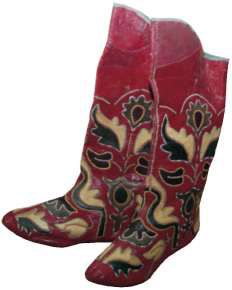
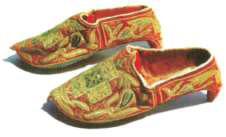 Art of shoes and boots owned master – master. Shoes made of different kinds of skins, which craftsmen – charmgar – kunchilar – produced from sheep (charm), goat (kayroki, Buzi), bullock (Bulgar) and other skins. Skin coloured in different colours. In Tashkent a shoemaker’s work mainly in Beshogach and Sebzar parts of the city. Boots made here and exported to other of the city.
Art of shoes and boots owned master – master. Shoes made of different kinds of skins, which craftsmen – charmgar – kunchilar – produced from sheep (charm), goat (kayroki, Buzi), bullock (Bulgar) and other skins. Skin coloured in different colours. In Tashkent a shoemaker’s work mainly in Beshogach and Sebzar parts of the city. Boots made here and exported to other of the city.
The most popular male shoes are shoes – kavush, or kaush, which in each region had its own features. For example, Tashkent kavushi differed a high heel and the fine woven nose. Other footwear men wore boots mukki, chorir. One of the varieties of such boots – small ethics, or kun ethics, as their called in Ferghana. They were made of thick, but soft leather, painted in brown or yellow, sometimes suede side up. More light-boots – takaki – sewed from goat skins. They had a high heel and embroidered with silk thread backdrop. These boots were young well-to-do men. On holidays or during a sports game of Ulak (kozlodranie) wealthy men wear boots cal Hasani or Bulgari ethics of red skin with long tops. They had a high heel and back, embroidered thread-of-gold-pattern gajdumi. In XX century boots the bark of the ethical began to sew from black leather, mainly from chrome.
Widely spread among the the urban population were ichigi – boots without heels and solid tail, with soft soles, their called mahsi or мардона and worn together with кавушами, which usually filmed, entering the room. This the custom was caused by necessity to to keep clean the floor, always Brussels carpets, Oriental carpets or koshmami. Especially valued ichigi with каушами, made of lacquered leather амркон. Male ichigi and shoes were longer than women’s and were made from the more solid of the skin. In rural areas, together with the boots were also chorik – rough half-open shoes without a boot made of a single piece of rawhide. Edge collected in the narrow leather the strap for the manufacture of which took the skin of horses and camels. The inhabitants of the steppe and mountain areas were mainly of a small ethics, mukki, чорик – old kinds of shoes. chorik, according to the testimony of Mahmud Kashgari (XI C.), was the shoes of the poor. They could do each. Short boots toshtuvon, similar to mukki, made of solid dressed leather, sometimes at a low heel. A variant of them were uyurtma ethical, who did not have heels and with upturned toes. Shoes пойчаки made from a single piece of rawhide leather with outer seam length the tops reached to the knees. The ankles tied пойчаки long string.
Shepherds on the distant mountain pastures were wooden shoes on three legs – tovuldi – rock, allowing them to overcome rocky trails and Wade through Brooks. Tovuldirok wear and a house in the rainy weather. They wear or on bare feet, постелив insoles or straw, or on custom-made sheepskin leather fur inside ichigi Teri mahsi, the closing of the calves or on the leather ichigi mahsi. During the work in the field wore Hhom kaush, made of raw cow or horse hides. The women’s craft shoes sewed the local craftsmen Usto – ttikduz, maksiduz, kavushduz. The main type of women’s half-closed Shine – Malla kavush – from yellow or brown skin. More high-quality shoes were made of local suede (kemukht) green – cook kavush. Wealthy women wore shoes nogayki, Hakkari or bark kavush from a bright, mainly chrome skin, with thick soles. The heels of his shoes were high and noses relatively narrow. In Tashkent were common zayfona kavush – women’s shoes at a low – heeled shoes, with narrow noses and low backdrop. In the summer of kavushi worn on bare feet, in the autumn and in the spring – with soft ichigami mahsi. Women – the city, coming out of the house, be sure to wear ichigi of black Kozlova skin, it was considered improper, if foreign men will see not only the bare the legs of a woman, but also the ends of her trousers, or at least circles surrounding them bottom of the tape. For young women and girls nailed boots mahsi, boots nimchkma, high boots on heels – chakma, leather black kavushi. The tops of boots often cleaned. Children wore kavushi, boots, ichigi, mukki, chorik and etc. Children’s mukki sometimes decorated with a brush, attached to toe. Children’s ichigi mahsi sewed made of soft, red-brown skin, wizard called bachkanachilar.
Interesting way of getting shagreen, for which used horse’s skin. The skin stretched on the special frame was placed on koshmu and was covered with a layer of red millet. From the top of her closed pieces of felt and feet trampled the millet softening the skin. Three days later, when the skin dried, millet removed, skin removed from the frame and scraped, and then painted. From the beginning of the XX century leather kavushi began to supplant rubber factory galoshes with low heel-and closed-sharp-nosed ahead. They released Russian factory for sale in Central Asia. Leather kavushi preserved in the ritual and, first of all, in the burial suit. Especially rich and ornate were soft gold embroidery boots and kavushi, which made the Bukhara masters. They were manufactured of colored smooth velvet and richly cleaned floral ornament of shimmering gold threads. The lining of the boots was made out of local handicraft and tissue only was the sole leather. Customers such shoes played himself Bukhara Emir, his court and the very wealthy people. Samples of this shoes today are exhibited in museums Uzbekistan as true masterpieces of folk – applied art. No less interesting Shakhrisabz shoes, decorated with solid embroidery ироки (cross, half-cross). Small vegetable ornament and original colours create a pleasant festive mood. Lining and sole boots are made of the color of the skin. One of the most significant collections of footwear is located in the ethnographic Fund of the State Museum of the history of the Uzbekistan Academy of Sciences of the Republic of Uzbekistan, where contains about 200 samples men’s, women’s and children’s shoes, collected in the Museum in different years in the course of the historical-ethnographic expeditions in Andijan, Kattakurgan, Smells, Шахрихан, etc. Part of the Shoe purchased in Tashkent. Some of the samples did in the 80-s yy. XX century from the Republican house of models of footwear and Tashkent Shoe factory № 2. This is a different kind of boots artisanal production of leather, painted in brown, light – and dark-brown, red, black, light-yellow, green color type сагри, rough leather, chrome and patent leather, with heels and without heels, wooden, leather, patterned from several layers of the skin, with iron calk and without podkovok, decorated with embroidery, leather tassels, кантиками and etc. So, men’s boots from the collection are made of inverted inside out of the skin, without lining, on the double sewed soled, covering the heel. They are embroidered with green and red threads on the junction of the backdrop to the top, the pattern on the back has a view of the black bars. On the heels of passes edging of red and white threads. Heels with soles for the sustainability of the joined iron brackets. Visors shoes are decorated with a brush of a few tight leather strips. The men’s boots from the collection of the red skin – heels wide, leather, dialers, of medium height, fastened with wooden nails. Sole – double. Black embroidered pattern adorns союзку and back, between which is sewn edging. Boot from the top are also decorated with tassels from the leather strips, but the brushes are not from behind, as in the first boots, and the front and rear and have a loop.
Men’s boots of the collection made from individual pieces of a dark-brown skin. The top of the tops of надставлен leather covered, pasted on both sides of the variegated cotton cloth (red with white flowers). On the connection shoes with vamp and a farm-house has embroidery in four lines of green threads. The sole leather, thin, laced threads. Heels of the green skin attached horseshoe iron nails. Top boot the men’s boots made of light-brown skin, nadstavlen high double visors, the first white, the second – yellow color. Backdrops with two the parties filed a vertical blue thread. Soles Sew. Heels are high, leather, patterned, with iron horseshoes, strengthened hard brackets. Interesting men’s boots, which served for riding. They are made of brown leather, the high stiletto heels, with iron brackets. The backdrop narrow. The sole of white leather, thickly padded iron nails with big hats. Top of the boot надставлен the high peaks of white leather, with silk seam Duru and white dzhiyakom.
Male kavushi – leather sagri green color – brown leather lining. Brown leather outsole is laced through the coarse threads. Heels patterned, medium-sized, broad. In 1948, at the edge of buildings on the street Buttermilk, № 73 in the city. Tashkent were found kavushi with a little bit of curved toe, made from the skin сагри. The heel of the round, acute, with iron brackets at the end. 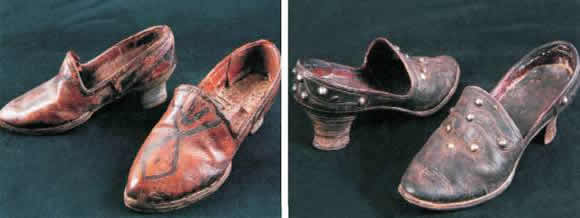 The sole is covered with continuous carnations with curly hats of different sizes. Interesting mukki kavush, designed to walk on the sand. They are made from light-brown, inverted inside out, the skin. The sole and the heel carved from the same the piece of bread, front – separately. The edges are covered with brown stripe skin coarse coarse thread in two lines. To them sewn extra long strings in the form of narrow leather strips for pulling top. Male mahsi-ichigi of skin сагри green have the lapels of brown leather and lining from the fabric. The insole leather, brown color.
The sole is covered with continuous carnations with curly hats of different sizes. Interesting mukki kavush, designed to walk on the sand. They are made from light-brown, inverted inside out, the skin. The sole and the heel carved from the same the piece of bread, front – separately. The edges are covered with brown stripe skin coarse coarse thread in two lines. To them sewn extra long strings in the form of narrow leather strips for pulling top. Male mahsi-ichigi of skin сагри green have the lapels of brown leather and lining from the fabric. The insole leather, brown color.
Interested in women’s shoes. So, women’s boots handicraft production made of green skin. Shoes and the backdrop of carved from one piece. The top is flanked by pink skin. Head пришивные. Leather sole shot down in two a number of wooden nails. Her boots on high thin wooden heels with leather decorations. In the Museum collections are female cook kavush, they made from the skin сагри green in color, with a sharp, curly up the spout. Head sewn inner seam, backdrops scheduling under the schedule. Sole double, leather, padded handicraft iron nails with big hats. Insoles – from brown skin. Heels high thin, wrapped in copper wire with spiral-a complex кантиком and bloody-iron подковками. Women’s кавуши of the collection are the sole of dark-brown skin, patterned leather heel, covered with black paint. The insole – from the skin of the crimson color. Top sewn seam irokki, ornament geometric, color embroidery – yellow, red, blue, black, green. Tashkent kavush – from skin sagri green colors are sharp, angled up the spout and thin high heels with iron calk. The region with the external side by a narrow white leather braid. Double sole of leather sagri continuous shot down handicraft iron nails. Women’s ichigi black leather sewn on strip on izvorot, then twisted Them with pointed toes, without lining. The soles of narrow, leather, brown color. The soles and backdrops ornmentirovani thin squeezing lines. To the top of the boot sewn narrow leather ears. The other women’s ичигов the tops of the top trimmed with a white cloth, back – leather sagri green. The women’s ichigov from the collection of the backdrop of the skin cagri framed embroidery in three lines of pink thread. Top boot ichigov from the collection of nadstavlen visors the red leather, and the top of boot female Tashkent ichigov nadstavlen strip of black leather, of a width of 3 see, below visrochen on a typewriter black threefold first pattern. Backdrops figured out the skin sagri. As we can see, making may be different. In the collection there are also ichigi, made of brown and yellow skin. Especially elegant ichigi the bride (pistonli mahsi), bought by the Museum in 1988 in г.Chist. They consist of a roll, slip, boot and Shoe soles. Ichigi patent leather, shoes are decorated with curved line and metal sheets.
Children’s boots этикча from the collection of the Museum of the history are made in 1979 in Andijan from the red skin amrkon. Backdrop and souzka decorated with multilobe pattern made by colored enamel. Sheath is also decorated with the white-crimson enamel vegetative patterns and in addition 4-spade patterns, executed machine stitch. The children’s Tashkent ichigov light-brown soles partially painted the black paint. Other children’s ichigi made from dark-brown skin, have sewn on top of the strip red leather. 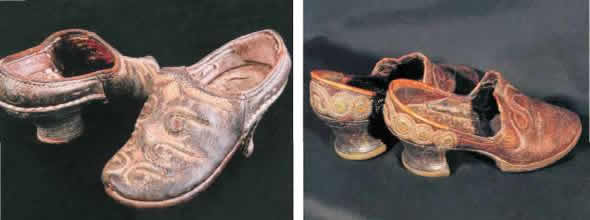 On backcloth inserted trimmed with colored threads pieces of skin сагри. Another children’s ichigi of skin kid black decorated with applique from small pieces of leather of various colors. Children’s кавуши have top embroidered seam ироки, color thread – different. The heel of a small, wooden, painted in black color. The sole of the dark-brown skin, the lining of the crimson of the skin and the red color of fabric. There are in the collection of and boots бачкана ethics, designed for kids. They are made from the skin of a black color амркон and decorated with ornaments made machine stitch and painting paint. Were purchased in the city. Shahri – Khan from the author M. Oripov in 1973.
On backcloth inserted trimmed with colored threads pieces of skin сагри. Another children’s ichigi of skin kid black decorated with applique from small pieces of leather of various colors. Children’s кавуши have top embroidered seam ироки, color thread – different. The heel of a small, wooden, painted in black color. The sole of the dark-brown skin, the lining of the crimson of the skin and the red color of fabric. There are in the collection of and boots бачкана ethics, designed for kids. They are made from the skin of a black color амркон and decorated with ornaments made machine stitch and painting paint. Were purchased in the city. Shahri – Khan from the author M. Oripov in 1973.
In the Museum collection there are several types of wooden shoes tovuldirok, men and children. They have the form of deep galoshes, on three legs. Are made of one piece the tree. Sock a very deep, closing almost the entire rise legs, slightly curled up. The backdrop of the low, a straight line. One leg is located at the rear, two – close to one another closer to toe. Sock can be ornamented carve diverse patterns and painted in black the color, the feet are bruised iron. In the 80-ies. XX in. Sh. Abdurasulov gave the Museum of men’s large size товулдирок made his grandfather A. Hurmatovim. They tselnorezannye of longitudinal bars of a solid, seasoned, moisture-resistant wood mulberry tree. Used such methods threads, as vystrugivanie, grinding, which allowed to identify the beautiful, fine-grained structure of the wood, her brown, pink-brown, yellowish shades. Tovuldirok have a traditional deep form, on three legs-stand, designed oblong the tip of the front curled up, rise high vertical cut, framed with a ribbon of black artificial of the skin. Outset more subtle than the front. Separate samples of leather shoes are available in a number of other the Museum’s collections. So, in the village of Shamatan Shahrisabz district of Kashkadarya region in October 1956. 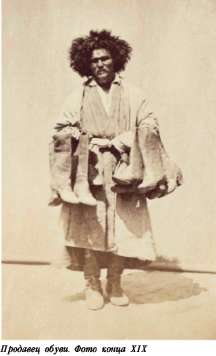 party the expedition R. Yakubovoy were acquired by the women’s lacquered kavashi decorated with on both sides horse riding and backdrop. The black skin notches made in the form of narrow Crescent and almond shapes, from which the the receding line of small circles, with the internal the part of these cuts closed skin pink; the backcloth the slots have a form of strips with pointed end. Up in the middle of the cut and put together two white crosses. Sole, insole, lining leather, sole it is sewn. In the same village acquired amirkon – weight – women’s ichigi, also made in the handicraft way from the black lacquered the skin on the yellow leather-soled shoes. In the Museum there are samples of footwear gold and the embroidery a cross ироки. Among them, the men’s gold embroidery boots with zaovalenny competent toe, on the average height of the leather boots with metal подковкой, the sole of leather, on the edges of the embroidered cotton. High shoes, advanced up-end “visor” from the white velvet, on the edge of a padded red Chlmoy and widely branching edging. Lining – of handicraft silk duroya with abrovim pattern. Boots all are decorated with gold embroidery zarduzi-zaminduzi, executed gold and silver thread. In medallions used red and green velvet. Pattern: in the foreground, at the bottom of the front of the boot and the the center of the tops of the solid gold background with two large round medallion. Inside each is located the six-point star of red velvet, in the center of which gold thread sewn a six flower socket with the exhaust from it sprouts. Between large medallions embroidered in silver thread bines and two small medallion with inserts of green velvet. On the sides of the boot – the same two round medallion, as in the front the plan. On the back – a six socket with plant shoots. Height – 50 cm. From the collection of interest pointy-gold-embroidery male kavush, with the up with the toe of a thin heels, dressed in metal horseshoe. Lining – red leather sole – from several layers of the skin, its bottom layer has Kant from the green skin сагри. The sole thickly padded cottage with a large head nails. Top is decorated with gold ornamentation in the technique of зардузи- gulduzi made by a silver thread with the inclusion of red and the purple thread in the welding of small parts. Pattern: roll on a green background with three large round rosettes in фестончатом framed. In the field between them – vegetable shoots with four – and a six floral rosettes. On the backdrop pattern is identical to the front, but smaller.
party the expedition R. Yakubovoy were acquired by the women’s lacquered kavashi decorated with on both sides horse riding and backdrop. The black skin notches made in the form of narrow Crescent and almond shapes, from which the the receding line of small circles, with the internal the part of these cuts closed skin pink; the backcloth the slots have a form of strips with pointed end. Up in the middle of the cut and put together two white crosses. Sole, insole, lining leather, sole it is sewn. In the same village acquired amirkon – weight – women’s ichigi, also made in the handicraft way from the black lacquered the skin on the yellow leather-soled shoes. In the Museum there are samples of footwear gold and the embroidery a cross ироки. Among them, the men’s gold embroidery boots with zaovalenny competent toe, on the average height of the leather boots with metal подковкой, the sole of leather, on the edges of the embroidered cotton. High shoes, advanced up-end “visor” from the white velvet, on the edge of a padded red Chlmoy and widely branching edging. Lining – of handicraft silk duroya with abrovim pattern. Boots all are decorated with gold embroidery zarduzi-zaminduzi, executed gold and silver thread. In medallions used red and green velvet. Pattern: in the foreground, at the bottom of the front of the boot and the the center of the tops of the solid gold background with two large round medallion. Inside each is located the six-point star of red velvet, in the center of which gold thread sewn a six flower socket with the exhaust from it sprouts. Between large medallions embroidered in silver thread bines and two small medallion with inserts of green velvet. On the sides of the boot – the same two round medallion, as in the front the plan. On the back – a six socket with plant shoots. Height – 50 cm. From the collection of interest pointy-gold-embroidery male kavush, with the up with the toe of a thin heels, dressed in metal horseshoe. Lining – red leather sole – from several layers of the skin, its bottom layer has Kant from the green skin сагри. The sole thickly padded cottage with a large head nails. Top is decorated with gold ornamentation in the technique of зардузи- gulduzi made by a silver thread with the inclusion of red and the purple thread in the welding of small parts. Pattern: roll on a green background with three large round rosettes in фестончатом framed. In the field between them – vegetable shoots with four – and a six floral rosettes. On the backdrop pattern is identical to the front, but smaller.  Such кавуши were necessary component gold embroidery costume court of Bukhara the Emirate. In funds of the Museum are stored also colourful women’s ichigi mahsi with a velvet horse riding, decorated with embroidered plant ornament islimi technique zarduzi-zaminduzi on a lining of adras with abrovimi patterns and leather sole (Bukhara, end of XIX C.), and women’s ichigi and kavasi made embroidery a cross iroki, patterns floral-vegetal, the sole and lining made of red leather (Shahri – Sabz, the beginning of XX C.).
Such кавуши were necessary component gold embroidery costume court of Bukhara the Emirate. In funds of the Museum are stored also colourful women’s ichigi mahsi with a velvet horse riding, decorated with embroidered plant ornament islimi technique zarduzi-zaminduzi on a lining of adras with abrovimi patterns and leather sole (Bukhara, end of XIX C.), and women’s ichigi and kavasi made embroidery a cross iroki, patterns floral-vegetal, the sole and lining made of red leather (Shahri – Sabz, the beginning of XX C.).
When studying Shine Karakalpaks you can also trace the ancient features of their material culture. Written sources relating back to X., contain information about the population of the North Khorezm gaiters or gaiters, such degde or uyik. Were they from the white felt, ornamented pattern koshgar muyiz (the RAM’s horns) and dressed men in a strong frost inside the boots of yalovoy skin. Herders, fishermen and farmers wear shoes Sharik (шарып) from rawhide head skin of a large cattle. Cutting the skin the size of the feet, they subsequently mounted it with laces on the sides. Among footwear made of leather craftsmen-shoemakers – etiksi, the most common in Karakalpaks were AK Pusta – men’s pointy boots, with elevated rounded toe and geuish – shoes, made from yalovoy leather, leather soles and order high heels, reminiscent of European style women’s footwear, etc. One of the samples of geuish (private meeting) has embossed small dot pattern on the skin in the form of crosses and a diamond. Shoes in front of additional laced metal (silver) wire in the form of twisted Koshkar muyizov (horns of the RAM), performing conservative the function. The backdrop decorated small bronze-studded with more than complex ornate pattern in the form of three pairs of muyiziv all the same silver the wire. In the center of the canvas, over heel – 4-I have a pair of stylized muyiziv, similar to the the horns of mountain goats. To the base of the 6-inch heels, expanding down, attached bronze-cast frame, repeating semioval the form of heel. On the one hand, this metal detail strengthens the basis Shine, on the other – when walking her the sound of touch with the earth’s surface or sex attracted the attention by their beauty. A pair of shoes, similar in form to the above mentioned, has closed the surface of the front of the element in the form of Kurbakov (the frog). Stylized image of a frog was a symbol of fertility and talisman water. He highlighted with a dark colour on a light brown background of the skin. Several geometric elements (among they triangles) issue the rear part of the shoes with additional embossed on the skin and typesetting 5-inch heels. Women’s boots with high heels made leather handicraft manufacture шерим or the purchase of the skin етик. A separate fishing was the manufacture insoles for кавушей, boots and other footwear. Insoles made of imported,and the so-called кашгарской felt blue, yellow, red and white colors, and the also from the local thin felt dark-brown color. The insole compiled from two pieces of felt, between which stitch up stretched-out reed buyra Chub, increase the force of resistance insoles. Edge of insoles sheathed after adjustment for Shoe size a buyer. Insoles cleaned on the edges and in the center of the multi-colored patterns. Placed on the shelves Studio in a picturesque order insoles attracted a buyer brightness and intricate pattern embroidery. In Tashkent at the end of the XIX – the beginning of the XX century insoles were made in 40 workshops. In the collections of the Museum are presented two kinds of insoles: made of felt, dyed and grey orange color. Insoles sewn on the edge and in the middle of the the first – and-white, the second – white and blue thread.
In the preserved archival inventories exhibits, presented for the demonstration at the XVI all-Russian industrial and art the exhibition of 1896 in Nizhny Novgorod, are the boots of mountaineers and mountain style; galoshes wooden highlanders; ichigi with men’s Shoe; ichigi Uzbek with shagreen Shoe, i.e. with kavushami, some well-cured of shagreen skin; ichigi women with Shoe; children’s boots with sewn-in heels, shoes children without heels; galoshes (kavushi), embroidered silk, heels, shoes, embroidered with silver; boots, covered varnish; shipaki – galoshes for adults from the green shagreen, from the black and yellow the skin; bachkona – children’s ichigi with shagreen green and black Shoe; women’s ichigi with shagreen green Shoe, boots with high heels; tashbaan – boots for an unskilled worker. Here are the examples of different skins, of which the shoes were made, including. bull, farrow and trestle, red, white, yellow, green, the black. In such shoes, really, wanted to seven fights miles of time.
Shamuhamedova Dinara
